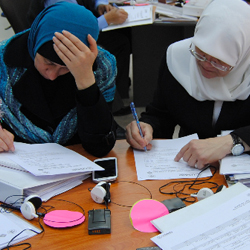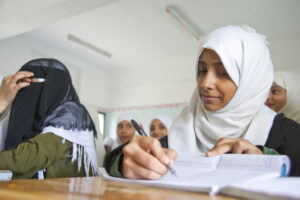Strengthening education systems with good governance: Lessons from Jordan, Yemen and Nigeria
By Ashley Williams
Safe, equitable access to quality education is a worldwide challenge, and weak governance can derail education efforts. People often think about education as what happens in a classroom, but there is an entire system behind it that must function well for students to succeed.
If a government cannot hire and retain teachers, education availability and quality suffer. If ministries duplicate efforts because they did not collaborate, students can receive fewer resources.
The everyday mechanics of governing make the magic of education possible. Creative works around the world to transform education systems by building government capacity to respond to student and labor market needs.
“Our projects in countries like Jordan, Yemen and Nigeria show how investing in systems plants seeds for education to flourish,” says Cory Heyman, Vice President of Creative’s Education for Development division.
Creating a national teacher policy framework in Jordan
 Jordan’s growing population of school-aged children, the COVID-19 pandemic and an influx of refugees from Syria and elsewhere are straining the country’s public education system.
Jordan’s growing population of school-aged children, the COVID-19 pandemic and an influx of refugees from Syria and elsewhere are straining the country’s public education system.
Despite the government’s best intentions to meet these burgeoning needs, the Ministry of Education and the Ministry of Youth continue to confront internal challenges, like systemic barriers, resource limitations, poor coordination among agencies and the absence of reliable metrics, among others. The impact is evident across the youth and education sectors, where reforms are lacking to help children and youth reach their full potential.
USAID’s Jordan Technical Assistance Program seeks to transform the organizational culture and improve the systems (e.g., human resources, finance, etc.) and abilities within the Ministry of Education and the Ministry of Youth to ensure officials can implement much-needed reforms.
One measure they are taking is to create a new teacher policy framework. The framework includes making teaching a more attractive profession, developing systems to train educators and creating career pathways.
“These elements will help improve how the society thinks about teachers and further professionalize the field, ultimately improving the quality of education,” says Mamdouh Fadil, the project’s Chief of Party.
Good governance supports education system sustainability by creating a legal framework based on accountability, transparency, open dialogue and participation. The new teacher policy framework builds a system that encourages excellence, activity and creativity and supports better teacher development and lifelong learning.
Strengthening HR and governance in Yemen

Conflict and displacement in Yemen have depleted Ministry and school staff, leaving a fractured and unsupported education system. The USAID Gateway to Education project is identifying and addressing gaps in the administration, governance, personnel, and delivery of functional, safe and inclusive education.
With Save the Children as the lead implementer, Creative has worked with the Ministry of Education to study how it can improve service delivery in the education sector. One piece of this has been researching what teachers already know, how they’re applying that knowledge in the classroom and what the Ministry has in place to train teachers over the lifespan of their careers.
With this information, the project and Ministry are working together to create new policies that restructure recruiting — so they can get the right people into the right education jobs — and their learning management system, which is a tool to measure teacher professional development over time.
“Investing in the human resources side of education governance is critical. Children have access to better teachers when the Ministry has the right policies in place to recruit and support educators,” says Kate Fleming, Senior Project Director at Creative.
Applying “the 5 Cs” in Nigeria
 According to UNICEF, Nigeria is home to one in five of the world’s out-of-school children. While education is technically free and compulsory in the country, it is not translating to students in seats.
According to UNICEF, Nigeria is home to one in five of the world’s out-of-school children. While education is technically free and compulsory in the country, it is not translating to students in seats.
“A major factor promoting this unfortunate situation is the country’s high population growth rate (2.41%) without a corresponding increase in educational provisions,” says Nurudeen Lawal, Chief of Party for the USAID-funded LEARN to Read program. “Nigeria’s education spending is below the international benchmark and the resources are allocated inefficiently, with southern states spending significantly more on education than northern states.”
Countless successive governments have declared an education crisis in Nigeria, but governance issues continue to create barriers to quality, accessible education. The many agencies, commissions and institutions that define Nigerian government structures form a complex web of interests, responsibilities and authorities with overlapping roles and competing demands.
LEARN to Read recognizes that evidence-based classroom interventions are necessary in Nigeria, but they are insufficient on their own. The project must strengthen governance and the systems that underpin early grade reading at all levels to achieve transformational change.
“LEARN to Read works with the government to transform attitudes about reading at every level of the reading ecology that surrounds a child,” says Scott Frick, Creative’s Senior Project Director. “At the state level, for example, this can look like using social behavior change research to help officials understand the onus and opportunity for supporting learning through planning.”
This involves implementing the 5Cs framework: context, collaboration, coherence, connection and continuation. We must understand the complex government context in Nigeria and use that to make the right connections and promote collaboration at the federal, state and local levels. All of this must be mobilized towards a coherent, unified aim to shift mindsets and ensure effective early grade reading practices continue past the lifespan of the project.
“The 5 Cs ensure we’re tying everything together and considering everything needed for meaningful and sustained progress in a complex environment,” says Scott Frick, Creative’s Senior Project Director.
Effective systems rely on interdependence and interaction. Creating, implementing and maintaining an education system has many moving parts across government and other institutions. Systems need to collaborate horizontally between institutions and vertically down to schools. When this is done well, it can empower actors to do their part in bettering student outcomes.
“Organizational culture and behavior change are inherent in strengthening government systems to be responsive to its citizens. The work being done in these three countries are good examples of that,” says Susan Ayari, Program Area Director for Creative’s Education for Development Division.

